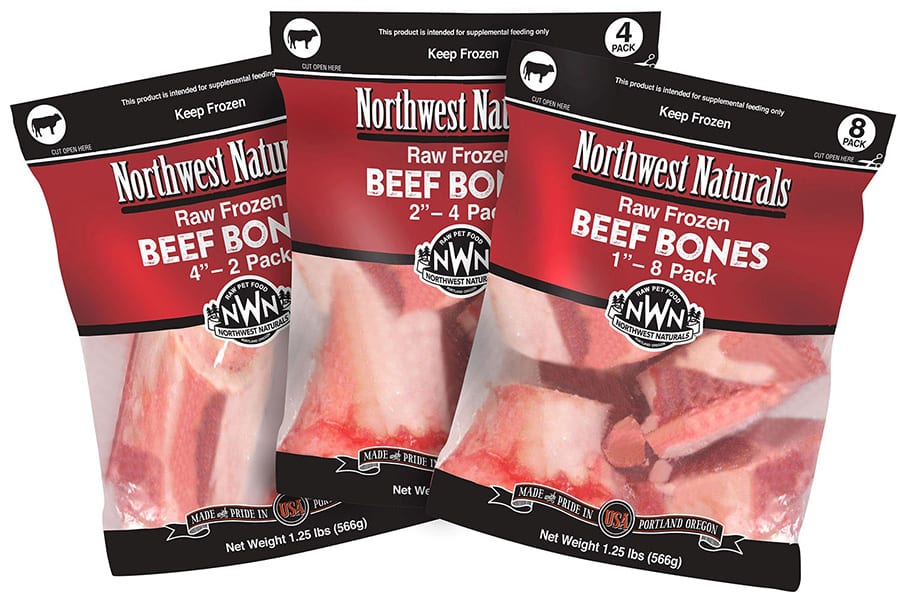
Tips on How to Boost Your Pet’s Health with Raw Bones
By Carol Kendig
Throughout history, pet owners have been reaping the benefits of raw bones as a staple of their dog’s diet.
To Gnaw or Not to Gnaw: that is the question:
Whether ‘tis safer for the stomach to digest the bits of grit from a very big bone,
Perhaps, forsooth, to lose a tooth or tearfully eschew the chew.
Would Shakespeare Have Given His Dog Raw Bones?
Up until the last century, for as long as humans and dogs lived together, our canine’s main diet consisted of prey animals and unwanted human food scraps. In Shakespeare’s time that would have been standard fare for canines. So, if the Bard did have a pup, he most likely fed her a diet that included raw meaty bones. These bones boost your pet’s nutrition and offer many benefits.
I imagine Shakespeare’s dog would be a small, scruffy Terrier-type, bouncing along by her master’s side to the local ale house or sitting alertly at his side during rehearsals. Will probably wouldn’t have known the scientific benefits of feeding bones to his dog. Veterinary science was rather rudimentary in the 16th Century. But what was nutritionally appropriate for a dog’s digestive system in Shakespeare’s day is still appropriate for our dogs today. No matter the date, bones are a worthy addition to a canine diet.
How and Why to Give Your Dog Bones:
Raw is Safer
First in order of importance is to only feed your dog raw bones, not cooked or smoked, which can cause dangerous splinters. Not only do raw bones offer the best health benefits (raw enzymes), but they do not fragment into slivers as smoked or cooked ones may.
Size Matters
Second, chose the correct size of raw bone for your dog. An easy rule about size is to match the size bone to your dog’s head. Chewing on a larger bone does not usually present a problem, but bones that are too small can create a choking hazard or be swallowed and cause problems. If Shakespeare had a twenty-pound Terrier, a femur would be an excellent choice. If he owned an English Mastiff, a large knuckle bone would be perfect. If the bard preferred a Pug, he might toss her a lamb breastbone or rib to chew.
Always Supervise Your Dog with a Bone
Third, always monitor your dog when she is eating a bone. Aggressive chewers can break off chunks of even a raw bone. Those pieces should be removed before they can be swallowed and cause esophageal trauma or a bowel obstruction. These determined pets can also fracture or chip teeth through the pressure they exert on these raw bones. If you are considering adding raw bones to your dog’s diet, careful supervision is the best policy when feeding bones whether yours is bone-driven or a nibbler.
The Added Benefits of Raw Bones
A fourth consideration when feeding raw bones, are the substances accompanying the actual bone: marrow and cartilage. Marrow is highly nutritious, and most dogs crave the taste. However, it is quite rich and can cause digestive upsets and loose stools if consumed in excess. Obviously, a Saint Barnard can tolerate more marrow than a Pekingese. For smaller dogs scoop out and freeze some of the marrow and divide for later feedings or limit the amount of time she can spend with her bone, remove it, refrigerate or re-freeze it and feed again at a future time. Cartilage is a natural source of collagen which helps keep a pet’s joints and ligaments healthy. It is a nutritious bonus when feeding raw bones.
Raw Bones are Messy
The fifth point involves cleanliness. Raw bones are messy. Your dog’s face and paws might be too, after enjoying her bone. They are best fed outside, in a crate or on a cleanable surface. Personal note, I feed raw bones in the backyard when weather permits, but on inclement days my dogs get freeze-dried poultry necks which they totally consume, leaving no debris. Again, chose an appropriate size from chicken, duck or turkey necks.
Finally, remember that a raw bone is one of a dog’s greatest pleasures. Not only will it satisfy her innate desire for raw meat, marrow, cartilage and the small particles of bone itself, but it is a naturally interesting activity for her. Shakespeare’s dog may have jogged all over London with Will and been entranced by his plays, but too often modern dogs lead a rather boring life without much mental stimulation.
Bones provide both mental and physical challenges. Have you ever watched you dog eat a bone? There is a lot of physical exercise going on: mouth, jaws, forelegs, paws, head and neck all get a good workout as the mechanical process of ripping, grinding, holding, positioning, pulling and gnawing contribute to a dog’s well-being. Mood elevating endorphins are released through this pleasurable activity, creating a happy, relaxed dog.
In answer to the question, would Shakespeare have given his dog a bone? Yes, he most certainly would, and probably many bones over her lifetime. While some people will choose to forgo bones for a variety of personal reasons, as a healthful, mentally and physically stimulating addition to your dog’s life, a nutritious raw bone can’t be beaten.